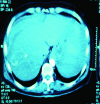Spontaneous rupture of hepatocellular carcinoma presented as low back pain to an emergency department: a case report
- PMID: 21686737
- PMCID: PMC3029435
- DOI: 10.1136/bcr.07.2008.0580
Spontaneous rupture of hepatocellular carcinoma presented as low back pain to an emergency department: a case report
Abstract
Introduction: Spontaneous haemoperitoneum due to rupture of hepatocellular carcinoma (HCC) is a surgical emergency and may have catastrophic outcomes.
Clinical picture: A 62-year-old male presented with nausea, dizziness and low back pain. There was no history of malignancy. Physical examination revealed a surgical abdominal emergency, but there was no physical finding that pointed towards a specific diagnosis. Laboratory studies revealed decreased haematocrit (27.6%) and increased INR (2.8) levels. A computed tomography scan showed a tumoral lesion within the fourth segment of the liver and fluid collection (haemoperitoneum) with normal vascular and intra-abdominal structures.
Treatment: Exploratory laparotomy was performed; the appearance of the liver was cirrhotic and nodular. Actively bleeding tumoral lesion was confirmed in fourth segment of the liver, "packing" applied with sponges to stop bleeding. On the post-operative day 22, the patient was discharged.
Conclusions: Spontaneous rupture of HCC is rare and should be considered in the differential diagnosis of non-traumatic spontaneous haemoperitoneum.
Figures
Similar articles
-
Spontaneous rupture of hepatocellular carcinoma: a case report and review of literature.Int J Clin Pract Suppl. 2005 Apr;(147):103-5. doi: 10.1111/j.1742-1241.2004.00257.x. Int J Clin Pract Suppl. 2005. PMID: 15875641 Review.
-
Spontaneous rupture of hepatocellular carcinoma in children.Afr J Paediatr Surg. 2010 Sep-Dec;7(3):188-90. doi: 10.4103/0189-6725.70424. Afr J Paediatr Surg. 2010. PMID: 20859028
-
Spontaneous Rupture of Hepatocellular Carcinoma in a Young Patient with Fatal Outcome.Case Rep Gastroenterol. 2018 Jan 17;12(1):19-26. doi: 10.1159/000486193. eCollection 2018 Jan-Apr. Case Rep Gastroenterol. 2018. PMID: 29515341 Free PMC article.
-
Surgical Management of a Spontaneous Hepatocellular Carcinoma Rupture in a Non-cirrhotic Liver: A Case Report.Cureus. 2025 May 4;17(5):e83441. doi: 10.7759/cureus.83441. eCollection 2025 May. Cureus. 2025. PMID: 40462777 Free PMC article.
-
Spontaneous rupture of hepatocellular carcinoma.Br J Surg. 1996 May;83(5):602-7. doi: 10.1002/bjs.1800830507. Br J Surg. 1996. PMID: 8689200 Review.
Cited by
-
Unusual cause of intraoperative haemorrhage: a lesson for patient counselling.BMJ Case Rep. 2022 Jun 9;15(6):e247951. doi: 10.1136/bcr-2021-247951. BMJ Case Rep. 2022. PMID: 35680280 Free PMC article.
References
-
- Miyamoto M, Sudo T, Kuyama T. Spontaneous rupture of hepatocellular carcinoma: a review of 172 Japanese cases. Am J Gastroenterol 1991; 86: 67–71 - PubMed
-
- Lee CC, Kim SH, Crupi RS. Emergency department presentation of spontaneous rupture of hepatocellular carcinoma. J Emerg Med 2002; 23: 83–5 - PubMed
-
- Chen CY, Lin XZ, Shin JS, et al. Spontaneous rupture of hepatocellular carcinoma: a review of 141 Taiwanese cases and comparison with nonrupture cases. J Clin Gastroenterol 1995; 21: 238–42 - PubMed
-
- Liu CL, Fan ST, Lo CM, et al. Management of spontaneous rupture of hepatocellular carcinoma: single center experience. J Clin Oncol 2001; 19: 3725–32 - PubMed
-
- Battula N, Srinivasan P, Madanur M, et al. Ruptured hepatocellular carcinoma following chemoembolization: a western experience. Hepatobiliary Pancreat Dis Int 2007; 6: 49–51 - PubMed
LinkOut - more resources
Full Text Sources

